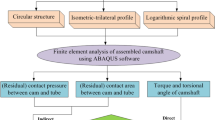Abstract
This study was conducted to determine the stress in sports car camshaft using the finite element method. The simulation was based on three conditions which include flawless, wear defects, and wear with initial defects such as early cracks. The results showed that the maximum normal stress in the model without defects was 7.8 MPa at the fillet area, while the stress in the worn model was 22 MPa. These values were below the material permit limit of 29.8 MPa. Meanwhile, the worn model with initial defects such as cracks had 252 MPa, and this exceeds the limit. It was also observed that the stress intensity factor at the crack tip was 17.9 MPa m1/2, and this indicates a propagation crack. Therefore, it was concluded that camshafts without defects or with wear and tear are safe to use, while those worn with defects such as cracks are not.
Access this chapter
Tax calculation will be finalised at checkout
Purchases are for personal use only
Similar content being viewed by others
References
Xu XL, Yu ZW, Mao SM (2020) Effect of extra-large compound calcium-aluminosilicate inclusions on cracking of camshafts. Eng Fail Anal 110:104408
Bhosale VN, Gaikwad SP (2013) Failure analysis of grey cast iron camshaft by mode of fracture. Int J Eng Res Develop 9:36–42
Pulkrabek WW (2004) Engineering fundamentals of the internal combustion engine
Bonatesta F, Altamore G, Kalsi J et al (2016) Fuel economy analysis of part-load variable camshaft timing strategies in two modern small-capacity spark ignition engines. Appl Energy 164:475–491
Dhavale AS, Muttagi VR (2012) Study of modeling and fracture analysis of camshaft a review. Int J Eng Res Appl (IJERA) 2:835–842
Bayrakceken H, Ucun I, Tasgetiren S (2006) Fracture analysis of a camshaft made from nodular cast iron. Eng Fail Anal 13:1240–1245
Li P, Li F, Cai A et al (2009) Fracture analysis of chilled cast iron camshaft. China Foundry 6:104–108
Husaini, Putra TE, Novriandika S (2020) Study of failure analysis of a fracture crankshaft pulley used on a truck engine. IOP Conf Ser Mater Sci Eng 739(1)
Wang G, Taylor D, Bouquin B et al (2000) Prediction of fatigue failure in a camshaft using the crack modelling method. Eng Fail Anal 7:189–197
Husaini, Iskandar ST (2001) Analysis of crack toughness on polymethyl methachrilite (PMMA) and nylon. Mech Eg J 4(1)
Lee S-C, Chang Y-B (1991) Fracture toughness and crack growth rate of ferritic and pearlitic compacted graphite cast irons at 25 °C and 150 °C
ASTM (2000) Standard specification for automotive gray iron castings 03:1–5
Rundman KB (2001) Cast irons. Encyclop Mater Sci Technol 1003–1010
Munandar D (2021) Study the causes of camshaft failure on car type SUV (Sport Utility Vehicle). Universitas Syiah Kuala
Jasdanwalla PH, Mulla S, Salman AM et al (2020) Design and analysis of camshaft using FEA. Int Res J Eng Technol 7:4412–4416
Husaini, Kishimoto K (2001) Mixed-mode fracture behavior of PC/ABS blends. In: Proceeding of SPIE—the international society for optical engineering 4317:111–116
Husaini (2015) Fundamentals of cracking mechanics. Syiah Kuala University Press, Darusalam, Banda Aceh
Acknowledgements
The authors are grateful to the Universitas Syiah Kuala for their financial support through Professor Research Grant No. 001/UN11.2.1/PT.01.03/ PNBP/2022. The authors are also grateful to the Department of Mechanical Engineering, Universitas Syiah Kuala, Banda Aceh, for making the facilities accessible.
Author information
Authors and Affiliations
Corresponding author
Editor information
Editors and Affiliations
Rights and permissions
Copyright information
© 2024 The Author(s), under exclusive license to Springer Nature Singapore Pte Ltd.
About this paper
Cite this paper
Ulul, A., Husaini, Teuku, E.P., Deski, M. (2024). Analysis of the Stress Concentration on the Sport Utility Vehicle Camshaft at Different Conditions by Using the Finite Element Method. In: Irwansyah, Iqbal, M., Huzni, S., Akhyar (eds) Proceedings of the 4th International Conference on Experimental and Computational Mechanics in Engineering. ICECME 2022. Lecture Notes in Mechanical Engineering. Springer, Singapore. https://doi.org/10.1007/978-981-99-7495-5_46
Download citation
DOI: https://doi.org/10.1007/978-981-99-7495-5_46
Published:
Publisher Name: Springer, Singapore
Print ISBN: 978-981-99-7494-8
Online ISBN: 978-981-99-7495-5
eBook Packages: EngineeringEngineering (R0)




